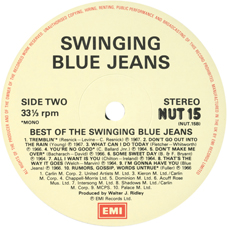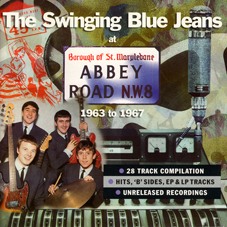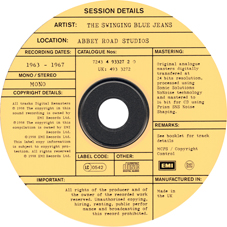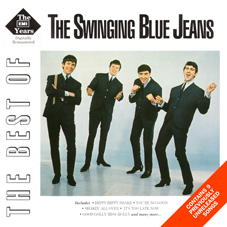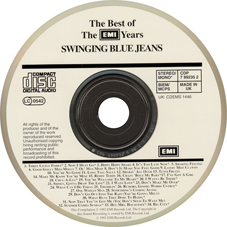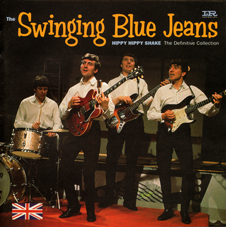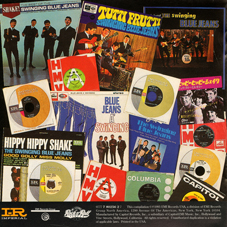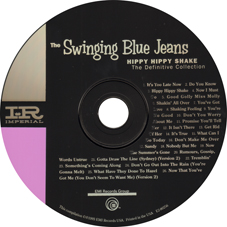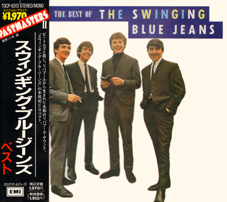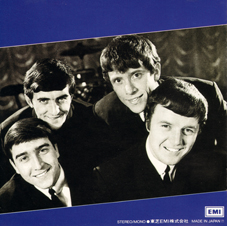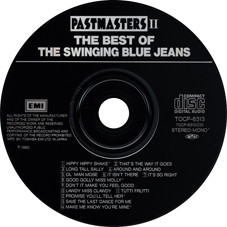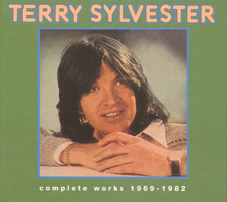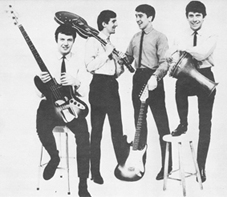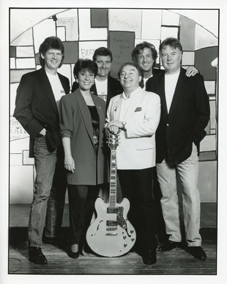There are songs for which the very first line of lyrics makes them instantly recognizable, like 'Well, it's one for the money' for instance. Another starts with 'For Goodness' Sake' and of course, it's 'Hippy Hippy Shake'. Although the original version was not theirs, the hit version was by The Swinging Blue Jeans, one of the earliest British beat groups whose success was somewhat short-lived but whose reputation rightfully increased as decades went by. They really embodied the archetypal Merseybeat group and as such were considered too lightweight by the rockers who complained about their 'watered down' versions of rock'n'roll classics. It was unfair, to say the least, so let's go back in time and take a fresh dive into the era of the nascent British Beat boom !
The founding members of the group played in skiffle groups as early as 1957, that purely English idiom which could be described as an intermixing of traditional folk songs, trad jazz and some blues, and played more or less exclusively with home-made instruments. Lonnie Donnegan was the boss there, along with Ken Colyer, Bob Cort, Chas McDevit and Johnny Duncan (who, incidentally, was American !). Ray Ennis (lead vocals & rhythm guitar), Norman Kuhlke (drums) and Les Braid (bass & piano) were part of The Bluegenes - that name sounded more American to them, and it was also inspired by Gene Vincent, no less. A good choice. Ralph Ellis (lead guitar & vocals) had his own group but disbanded it to join The Bluegenes. By 1959, the skiffle craze was dead and skiffle bands had turned to rock'n'roll for good. Electric instruments were now widely used. The Bluegenes soon hit the Liverpool club circuit, playing in some of the most celebrated venues like the Cavern - where they introduced the Beatles for the first time there in March 1961 -, then the Downbeat and the Mardi Gras from 1962 on. Like the Beatles and others, they would also play gigs at the famous Star Club of Hamburg, Germany. It is unclear when they first went there, and how many times, though. But the notes to their only French album of the sixties (HMV FELP 297, 1965) say that they backed up Bill Haley and Little Richard there in 1962.
Things sped up considerably after they signed a management contract with Jim Ireland in 1962. Jim was the owner of the Mardi Gras and Beachcomber clubs, plus he already managed the Escorts, a group whose career is linked to both the Hollies' and the Blue Jeans' as we'll see later on. An interesting book was 'British Beat' by Chris May and Tim Phillips (Sociopack Prod., 1974). They wrote : 'Under Jim Ireland's management, they received a barrage of publicity through 1963. They were sold as fashion leaders, popularising streamline leather jackets and smart bluejeans. They were also given exposure on a weekly Radio Luxembourg programme, 'Swingtime', sponsored by a firm of bluejeans manufacturers'. That's when the Bluegenes became the Swinging Blue Jeans.
Before being ultimately signed by HMV - which happened after the Beatles' first two hits -, they had auditioned for Joe Meek who rejected them. Had he signed them, they might have debuted before the Fab Four on record. On February 18, 1963, while 'Please Please Me' was climbing up the charts, they found themselves at Abbey Road to cut a demo session which produced 'Three Little Fishes', 'Ol' Man Mose' and a first try at 'It's Too Late Now'. When those three songs surfaced on CD decades later, we could hear how they were brimming with the energy and enthusiasm so characteristic of these English beat groups. Moreover, the musicianship was very good. They would end up being produced by a longstanding in-house producer named Walter J. Ridley for HMV (His Master's Voice), a branch of EMI through which the early RCA singles by Elvis Presley were issued in the UK, and apparently thanks to Ridley's input. That said, Ridley was no George Martin and the relationship between him and the Blue Jeans remained strained until the end of their collaboration.
We'll now follow the group's evolution by using their British releases as a guideline.
1963
HMV POP 1170 * It's Too Late Now (7XEA 20650) / Think Of Me (7XEA 20649)
They finally held their first proper recording session on May 18, 1963, while the Beatles were at the top of the charts for the first time with 'From Me To You'. The Ray Ennis composition, 'It's Too Late Now', was chosen as the A-side. It had all the ingredients of what was termed as Merseybeat : a simple but catchy melody, a relentless rhythm, ringing guitars in the backing and joyful harmony vocals. Released in June, it went to no. 30, which wasn't a bad placing but still a bit disappointing. The flip, largely forgettable, was written by Ralph Ellis and Norman Kuhlke.
HMV POP 1206 * Do You Know ? (7XEA 21082) / Angie (7XEA 21083)
The follow-up single was recorded on August 26, 1963, and hit the racks the following month - but alas, it failed to make the charts. Ray Ennis wrote 'Do You Know' more or less in a hurry and the song would have suited Freddie & The Dreamers better. The bits of piano here and there remind us of the Beatles' 'Misery' but in return, when you listen closely, you can almost hear a bit of the tune in the Beatles' 'I'm Happy Just To Dance With You' which would be recorded months later. It goes to show that the Merseybeat-type of songs was a style which really existed for a good couple of years. The flip, 'Angie', has evidently nothing to do with a later Rolling Stones hit.
Despite the failure of their second disc, they continued to benefit from an efficient publicity machine and the Swinging Blue Jeans were duly featured as a Liverpool beat group in the detective TV series, 'Z Cars'. That's where they performed their recently recorded version of 'Hippy Hippy Shake', and that's when everything fell instantly in place.
HMV POP1242 * Hippy Hippy Shake (7XEA 21138) / Now I Must Go (7XEA 21139)
The story has been confirmed that Bob Wooler, the famous DJ at the Cavern club, introduced the top side to the beat groups who performed there. 'Hippy Hippy Shake' was written and first recorded by its author, Chan Romero, a singer and musician from Montana, who sounded so much like Ritchie Valens that he ended up being signed by Bob Keane, former Valens' manager and producer, to his Del-Fi label. Recorded in April 1959, it came out as a single on Del-Fi 4119 as 'The Hippy Hippy Shake' (backed with 'If I Had A Way') but wasn't a hit. It was, however, released in Britain on Columbia (DB 4341) and that was perhaps the source of Wooler's discovery. The Beatles used to play it on stage ; a version recorded live in Hamburg on December 31, 1962, appeared on the then-much-talked-about 'Hamburg Tapes' LP in 1977. It's interesting to note that the Fab Four also played it many times on their BBC radio segments, before and after it was a hit for the Jeans who, on November 7, cut their excellent, straightforward cover version with an explosive guitar solo and a superb vocal from Ray Ennis. The mono mix is the best but the track doesn't lose any of its power when heard in stereo. They tried hard to get the feel to pull off the song like they wanted (some studio conversation can be found on the US CD, 'The Definitive Collection') but by take 5, they were done. They definitely found their signature sound there : Ray's vocal would now be double-tracked and peppered with a strong dose of echo over a cleanly recorded instrumentation.
Cut at the same session, 'Now I Must Go', sung by Ray and Ralph, is another Ray Ennis composition which shows how much those Merseybeat bands had all been influenced by the Crickets, with and without Buddy Holly. This song - especially its ending - recalls 'My Little Girl', a UK Top 20 hit for the Crickets from earlier in the year.
'Hippy Hippy Shake' hit no. 2 in England and (only) no. 24 in the States. It was also a smash hit all over Europe.
1964
Their biggest year, not surprisingly. There were gigs with Chuck Berry, Carl Perkins, The Animals, The Nashville Teens and others but alas, no tour in the States because of one in Sweden that supposedly couldn't be postponed - they were never invited back which certainly accounted for their lack of success over there. But they appeared in the first English film using the new (but short-lived) technique of Circlorama, in which the audience
was completely surrounded by screens arranged in a circle ; it was called 'Circlorama Cavalcade', and they performed their big hit. And later in the year, they were filmed live at the Mardi Gras while playing 'Long Tall Sally' for the purpose of a short BBC TV documentary about Liverpool called 'The Sound Of A City'. They were also seen in the studio with Walter Ridley, performing part of 'Hippy Hippy Shake'. Always looking smart and in full control. Three other groups were part of the cast, notably The Escorts and The Zephyrs. Incredibly, the Beatles were barely mentioned : all the hype was for the Swinging Blue Jeans !
HMV POP1273 * Good Golly, Miss Molly (7XEA 20816) / Shaking Feeling (7XEA 20817)
Was it a good idea to choose 'Good Golly, Miss Molly' as a follow-up, and do a rendition which, although extremely good, made it sound so similar to the previous hit ? It was their producer's idea. Contrary to belief, 'Good Golly, Miss Molly' was not recorded by Little Richard in the first place but by an excellent R&B vocal group called The Valiants (Keen 34004, with 'This Is The Nite' as the flip, reissued in 1995 on Early Bird 001, orange wax). Although it became a Rock'n'Roll classic after Mr Penniman waxed it in his usual style, the Valiants' original is totally stunning, faster and boasting a super guitar break.
The Jeans cut it on February 14 during a session which delivered three other great rockers. Ray Ennis was in really great voice as demonstrated on Johnny Kidd's evergreen 'Shakin' All Over' and the Joe Turner/Bill Haley/Elvis Presley staple, 'Shake, Rattle & Roll'. Both tracks would soon appear on an EP called 'Shake' (see below). The group also did a mighty fine version of Buddy Holly's 'You've Got Love' which, like all the other songs, featured a resplendent guitar backing and solo. For some reason, the latter remained unissued for thirty years until its inclusion on the US CD, 'The Definitive Collection'.
'Good Golly' was paired with 'Shaking Feeling', an early collective composition by the group - and an absolute winner ! Sung by Ralph and Ray, this fast number features an harmonica part during the instrumental break. Many fans, including Ennis & Co., would have gladly promoted it as the A-side.
'Good Golly, Miss Molly' peaked at no. 11 in England during a 5-week run, and at a rather low no. 43 in the USA.
HMV 7EG 8850 * SHAKE * Hippy Hippy Shake / Shakin' All Over (7XEA 1927) / Shake, Rattle & Roll (7XEA 1928) / Shaking Feeling
A genuinely smokin' rock & roll EP released in April, two full months before the Beatles' brilliant 'Long Tall Sally' EP - and nearly just as good.
HMV POP 1304 * You're No Good (7XEA 20844) / Don't You Worry About Me (7XEA 20845)
According to Ray Ennis, drummer Norman Kuhlke was often responsible for submitting ideas of songs to record to the group. One such song was 'You're No Good' which, paired with 'Chained To Your Love', was one side of Vee Jay 566, a single by Betty Everett, better known for 'It's In His Kiss (The Shoop Shoop Song)' and her duet with Jerry Butler on 'Let It Be Me'. It's safe to say that the Jeans did an outstanding job on that song - it oozes class all the way. Some studio conversation can be heard before take 3 on the UK CD, 'At Abbey Road'. The song came from the pen of a talented songwriter named Clint Ballard, Jr, who'll soon get mentioned again. There is some confusion about the recording date, however : April 25 is noted on the US CD 'The Definitive Collection' whereas May 8 is given on the above UK CD. But both discs indicate May 8 as the studio date for the flip, Ralph Ellis' 'Don't You Worry About Me', another good song with a catchy guitar intro.
'You're No Good' reached no. 3 in England but struggled to reach the US Top 100 at only no. 97. There, Imperial Records, who distributed the group's releases, chose 'Shake, Rattle And Roll' as the b-side. 'Don't You Worry About Me' appeared for the first time in the US on the 'Definitive Collection' compact disc.
.jpg)
.jpg)
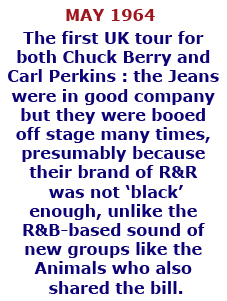
HMV 7EG 8865 * YOU'RE NO GOOD, MISS MOLLY * You're No Good / Don't You Worry About Me / Good Golly, Miss Molly / Angie
Their second and last UK EP, issued in July or August.
HMV POP 1327 * Promise You'll Tell Her (7XEA 20859) / It's So Right (7XEA 20860)
By the time of the recording of these tracks for the Blue Jeans' next single, the Beatles had already and simultaneously become pioneers and masters of a new trend : using only their own material for their singles. Of course, it took an amount of talent unseen up to that time. Having scored another big hit with 'You're No Good', the group was able to convince Walter Ridley to let them do two of their compositions for the forthcoming release. It was a magnificent coupling, once again crafted by the four of them. I certainly don't agree with Dawn Eden, who penned the excellent notes for the US CD, when she writes that 'Promise You'll Tell Her' would have been more at home as an LP cut. It's a haunting number with strong vocal harmonies. By contrast, 'It's So Right' is a terrific rocker - one of their best. Ray Ennis was a remarkable singer and guitarist, and there was real osmosis within the group. How can one imagine that such a record missed the charts on both sides of the Atlantic ?
Both tracks were put down in the studio on July 1, as well as 'Tutti Frutti' which replaced 'It's So Right' as the flip for 'Promise You'll Tell Her' in the States. The two respective b-sides would appear on the group's only UK album in November.
HMV CLP 1802 * BLUE JEANS A-SWINGING * Ol' Man Mose / Save The Last Dance For Me / That's The Way It Goes / Around & Around / It's All Over Now / Long Tall Sally / Lawdy Miss Clawdy / Some Sweet Day / It's So Right / Don't It Make You Feel Good / All I Want Is You / Tutti Frutti (2XCA 2623)
Amazingly, and despite the lack of action over there, the group had had a long playing album out in the States as early as April '64 (Imperial LP 9261 in mono, the stereo version being essentially rechanneled and thus to be avoided at all costs) with the famous sleeve showing four bluejeans hanging on a clothes line. It contained all of the group's Imperial singles up to that date plus tracks from the first UK EP and a rarity called 'Wasting Time', the only self-penned Les Braid song. 'Save The Last Dance For Me' was already on board, too.
The UK LP detailed above (and pictured at left) sported a somewhat similar cover although the pics of the group were totally different. The contents were vastly different, too. It was a splendid rock & roll album, from the re-cut of 'Ol' Man Mose' to the wonderfully syncopated 'Tutti Frutti'. All their versions of classics from Little Richard, Chuck Berry and Lloyd Price (via Elvis Presley) pack a solid punch and feature, as expected, great guitar sounds. Les Braid is responsible for adding the piano part to 'Lawdy Miss Clawdy'. Ralph and Norman share the vocals on 'Some Sweet Day', a song from the Everly Brothers songbook, while Ralph has the solo spot on 'Save The Last Dance For Me'. The surprise was to discover two songs penned by Hank Marvin and Bruce Welch of the Shadows ; in fact, John Chilton, who wrote the liner notes on the back of their LP (and who co-wrote 'All I Want Is You' with Jim Ireland), reveals that the two bands met and became good friends while on tour in Scotland, thus leading to the Shads giving 'That's The Way It Goes' and 'Don't It Make You Feel Good' to the Blue Jeans. However, and that's the bigger surprise, although Ray & Co. do very nice versions of the songs, they are nowhere as good as the ones recorded by the Shadows themselves on their brilliant 'Dance With The Shadows' LP of the same year.
Ray Ennis explains somewhere that they recorded their LP in two sessions which took a total of five hours to complete ! It does them great credit to have produced such a superb rocking album in so short a time.
A stereo version exists (CDS 1570) but it is excruciatingly rare ; you can have both the mono and stereo mixes in real great sound
on a UK CD housed in a digipack (EMI 8 56563, 1997).
HMV POP 1375 * It Isn't There (7XEA 20904) / One Of These Days (7XEA 20905)
After the rout of the previous '45, Walter Ridley gave the group an acetate of another song composed by the prolific Clint Ballard, Jr, so that they could rehearse it and cut it for their next offering. 'It Isn't There' was recorded by Johnny Burnette at his first session for Capitol in 1963 (#5023, backed with 'All Week Long') but made no impact charts-wise and didn't help to revitalize his career. A rather strange choice on Ridley's part, perhaps guided by the fact that the last hit was a Clint Ballard composition, so who knows ? One thing for sure, it's not an easy song to do and I've always thought that neither Burnette nor the Blue Jeans did it justice. They stuck to the original arrangement albeit with an harmonica in place of the big orchestra, however something doesn't seem to work. And it didn't. The other side, a rather weak Ray Ennis song, was certainly of no help.
Recording date : November 12. Release date : December 11. Chart action : none.
1965
That year was about to bring major changes in rock music. In 2000, the folks at UK mag, Mojo, cleverly compiled a special CD in association with Castle Music, to celebrate what they called rock's year zero...1965. In their own words : 'a thrilling big bang of sharp threads, top barnets, illicit drugs and incredible sounds'. I do agree : that's when rock & roll became rock, period. Groups had to be daring, and those without deep songwriting skills would soon meet tough times to last on the scene. Unfortunately, the Swinging Blue Jeans suffered from that lack of original material but they weren't finished yet - far from it.
HMV POP 1409 * Make Me Know You're Mine (7XEA 21411) / I've Got A Girl (7XEA 21412)
Indeed, starting the year with a throwback to 1958 can be considered as daring ! Conway Twitty had first recorded the growling, even menacing 'Make Me Know You're Mine' in Nashville in December '58 ; it was issued as MGM 12748 with 'The Story Of My Love' on the reverse side, and included in his first LP, 'Conway Twitty Sings' (E/SE 3744), the following year. The Jeans' rendition was powerful and atmospheric at the same time, faithful to the original in intensity and therefore totally satisfying, except that it flopped miserably.
The flip, 'I've Got A Girl', was another cohesive effort by the group typical of their dynamic style with an excellent, slick guitar break,
but perhaps a touch too reminiscent of the Beatles' 'She's A Woman' at times. Recorded on March 16, and pressed in April in the UK, the single wasn't even deemed suitable for release in the US.
The search for new material resulted in two sessions in June (9th and 14th) where at least two songs were recorded, perhaps only as demos since they didn't see the light of day until the US 'Definitive Collection' CD. 'Get Rid Of Her' and 'It's True', where composer credits are marked as unknown, are pretty good tunes with some commercial potential. But it was on July 30 that four tracks were cut at Abbey Road which would grace their next two discs and, ultimately, put them back in the charts.
HMV POP 1477 * Crazy 'Bout My Baby (7XEA 20452) / Good Lovin' (7XEA 21453)
Back in the charts but unfortunately, not with this one and it's a shame because it was really good. Ray Ennis said that they got much praise and rave reviews for it, but the sales didn't follow.
Suggested to the group by Chris Curtis (of the Searchers), 'Crazy 'Bout My Baby' begins with maraccas and acoustic guitars over a latin-tinged beat, quite a departure from all that preceded but very effective just the same. The vocals blend perfectly with the loping rhythm, and a flute is used for the instrumental bridge (perhaps with a little inspiration from the Beatles' 'You've Got To Hide Your Love Away'). A fine side.
'Good Lovin' ain't bad either : a frantic beater with more maraccas and the electric guitars back to the fore.
That same song was cut later in the year by an up-and-coming American group called the Young Rascals who took their soulful version to the no. 1 spot in Billboard in April 1966.
Meanwhile, this was the second '45 by the Blue Jeans to not be issued in the US. A shame.
Also cut around that time, and perhaps at the same session as above, were superb versions of 'Ready Teddy' (7XEA 21450) and 'Lovey Dovey' (7XEA 21451), the former sporting a super fine extended guitar break. Amazingly, and unknown to the group at the time, these two tracks appeared on singles...in Finland (HMV JO 1001) and in Norway (HMV AL 6131). Their frenetic take on the Little Richard classic can be found in stereo on the UK CD, 'The Best Of The EMI Years'.
1966
HMV POP 1501 * Don't Make Me Over (7XEA 22231) / What Can I Do Today (7XEA 22232)
Ray Ennis claims that they had wanted to cut the Dionne Warwick hit from 1962 (Scepter 1239, b/w 'I Smiled Yesterday') for quite some time but Walter Ridley wouldn't accept it. He adds that they were in Paris in '65 while Dionne was playing at the Olympia, so they went to see her backstage and told her that they wanted to cover her song, to which she heartily agreed. So they went back to Ridley and almost presented him with an ultimatum about the Hal David-Burt Bacharach composition ; reluctantly, he let them do the song, complete with a violin section for the first time (arranged by Harry Robinson). Ennis again did a fine job with the tune and proved Ridley wrong for the third time (he hadn't had more faith in 'Hippy Hippy Shake' and 'You're No Good' before). The song was their last hit of significance, although it only reached no. 31 in the UK charts. It didn't make the Top 100 in the US.
There was a very good flip side in 'What Can I Do Today'. It seems to me that Ralph might be using a Rickenbacker guitar for the figure which starts, and is used, throughout the song.
This record, released in January, would indeed mark Ralph's last appearance as a Swinging Blue Jean because he quit the group that same month for the domestic life. All those years of playing, touring and recording, plus the now rapidly changing music scene may have taken its toll on him. He was a likeable person, an impressive guitarist, in one word a centrepiece of the group. His replacement was a fellow Liverpudlian by the name of Terry Sylvester who sang and played guitar with the famous Escorts. He can be heard on the singles the Escorts cut for Fontana, including a version of 'Dizzy Miss Lizzy' which predated the Beatles'. It was the song that the band performed in a sequence shot at the Cavern in 'The Sound Of A City'. Terry's talent really blossomed during his three-year stint with the Blue Jeans before reaching an even higher level after he joined the Hollies in December 1968.
HMV POP 1533 * Sandy (7XEA 22264) / I'm Gonna Have You (7XEA 22265)
'Sandy' was recorded on May 9 at Abbey Road, Studio 2, like all the previous stuff, and did feature Terry Sylvester on lead vocal for a change. It was a real nice version of a minor US hit by Ronny & The Daytonas (Mala 513), the Nashville group led by John Wilkin and Buzz Cason, the writers of the song. An orchestra, again led by Harry Robinson, assists the Jeans to produce a smooth and melancholic ballad.
A remake of Betty Everett's 'It's In His Kiss', obviously titled 'It's In Her Kiss',
was recorded on that day but remained unreleased until the UK 'At Abbey Road' CD in 1998.
Before the May session, there had been at least two recording dates in March, certainly in order to try some material and test the waters with the new line-up. The least that can be said is that Terry instantly fitted in with the group. Consequently, a bunch of superb tracks were laid down during those two days.
'I'm Gonna Have You' seems to be the only original song submitted by the band, and it was written by all four of them. A good mid-tempo beater, it retains all the essence of the sound that established the Swinging Blue Jeans from the start. It is notable for a guitar solo created by a non-stop glissando on a string, à la 'Roadrunner' by Bo Diddley. Chosen as the underside to 'Sandy', this excellent single didn't restore the group to the hit parade.
The other songs were all cover versions, but boy, were they good ! Here's a rundown of the titles, hopefully with some useful info:
March 17
'I'm Gonna Have You' * ............................................ UK CD, 'At Abbey Road, mono
'I'm Gonna Sit Right Down And Cry (Over You)' * ....... UK CD, 'At Abbey Road, mono
March 18
'You Don't Love Me' * ............................................... UK CD, 'At Abbey Road, mono
'Do You Believe In Magic' * ....................................... UK CD, 'At Abbey Road', mono
'This Boy' * ............................................................... UK CD, 'At Abbey Road, mono
'Nobody But Me' * ...................................... US CD, 'The Definitive Collection', stereo
From above sessions and/or previous ones
'Gotta Draw The Line (Sydney)' * ............ UK CD, 'The Best Of The EMI Years', mono
'You're Welcome To My Heart' * .............. UK CD, 'The Best Of The EMI Years', mono
'I Wanna Be There' * ............................. UK CD, 'The Best Of The EMI Years', stereo
'I Want Love' * ....................................... UK CD, 'The Best Of The EMI Years', mono
'Chug-A-Lug' * ........................................ UK CD, 'The Best Of The EMI Years', mono
'I Don't Believe It' *
'Jump Back' *
'I'm Gonna Sit Right Down...' was cut by Elvis Presley in January 1956 to be included in his landmark first album (RCA Victor LPM 1254) and gets a fabulous Merseybeat treatment here, with a neat guitar break. 'You Don't Love Me' is the much loved Willie Cobbs classic (Vee-Jay 411) while 'Nobody But Me', written by Doc Pomus & Mort Shuman, was the flip side of 'Save The Last Dance For Me' by the Drifters (Atlantic 2071, 1960). The Beatles' 'This Boy' and the Lovin' Spoonful's 'Do You Believe In Magic' need no introduction, and are both delightfully performed by the group. 'Gotta Draw The Line', under that title, was recorded by the Three Degrees, a girl group produced by Richard Barrett (Swan 4224) ; there was also a version by soul singer, Darrow Fletcher. The Blue Jeans would attempt another try at the song in 1967. The funny 'Chug-A-Lug' comes from country artist, Roger 'King Of The Road' Miller, showing the eclectism and versatility of the group.
There was certainly enough great material for a second album, and a release was planned...in Canada, where the group's first album (same contents as the US counterpart but a totally different jacket) had been issued under the Capitol banner in June 1964 (T-6069, mono only). Titled 'Don't Make Me Over', again on Capitol (T-6159, mono only), it contained all the above songs marked with an asterisk (*) plus, of course, the title track. I suppose not too many Canadian fans were lucky enough to buy it then, because it was pulled off the market very quickly ; those who did have now a nice collector's item on their hands. It helps to better understand why Ray Ennis complained about their total lack of control over what was, or was not, released.
HMV POP 1564 * Rumours, Gossip, Words Untrue (7XEA 20283) / Now The Summer's Gone (7XEA 22284)
By that time, they had more or less run out of new self-penned compositions, the same fate that dogged so many groups of the first wave of British Beat. However, on October 3, they cut the ballad, 'Now The Summer's Gone', a collective effort which showcased their vocal harmonies in the best way. Walter Ridley had another idea for a top side and submitted a recent single by US band, the Knickerbockers, but apparently wasn't very precise about the side the Blue Jeans should cover. 'Rumors, Gossip, Words Untrue' was the one Ridley had in mind, but the other song on that Knickerbockers '45 (Challenge 59341) was the wonderful 'Love Is A Bird' which Gene Vincent was about to record, and probably the group's own choice. When they arrived at the
November 11 session that had been scheduled, a big moment of tension occured : according to Ennis, Ridley gave them an hour to rehearse 'Rumors...', and they did, although more than relunctantly ! The results were nevertheless pretty good, with the same pseudo-sitar sounds as on the original.
But to everybody's despair, the record bombed. The group had definitely lost its grip on the charts.
1967
If 1965 was a challenging year, then 1967 drew a real red line : outfits like the Swinging Blue Jeans had to choose between remaining a rock band or becoming a pop group. Their management and producer had clearly figured out that the second option was the one to follow.
On March 3, they re-cut 'Gotta Draw The Line (Sydney)', a more laid-back, much less punchy version which appeared in mono on the US 'Definitive Collection' CD for the first time.
At some point during that year, there were five Blue Jeans instead of four, with the addition of bassist Mike Gregory who was in the Escorts with Terry Sylvester. Consequently, Les Braid switched to keyboards.
However, for their next record, there would be only one Blue Jean - Ray Ennis, and on vocals only.
HMV POP 1596 * Tremblin' (7XEA 22318) / Something's Coming Along (7XEA 22317)
At the May 23 session, Ray was surrounded by session musicians plus an intimidating trio of female back-up vocalists of the highest caliber : Madeline Bell, Kiki Dee and Lesley Duncan. Bell had released several solo 45's on Columbia and Philips while doing session work, just like the wonderful Kiki Dee (on Fontana, before doing an LP for Tamla and recording for Elton John's label, Rocket) and Leslie Duncan (Parlophone and Jerden). The latter was also blessed with songwriting skills, incidentally 'Something's Coming Along' being a song she co-wrote. Ray acquitted himself perfectly well of Gene Pitney's lesser-known 'Tremblin' (Musicor MU 1245, b/w 'Where Did The Magic Go ?'), ably supported by a good arrangement (courtesy of Johnny Harris) and the three girl singers, but I still prefer the other side with its Motown-ish flavor.
Another good song, 'One Woman Man', was also cut at that session and became the flip side of the next '45.
It should be noted that, in spite of the lack of chart success in England and in the US, many singles by the group were also issued in other countries, European in particular ; as an example, 'Tremblin' saw a German release on Electrola with a nice pic sleeve to boot.
HMV POP 1605 * Don't Go Out Into The Rain (You're Gonna Melt) (7XEA 22330) / One Woman Man (7XEA 22319)
Could anybody seriously think that a cover of a most recent minor US-only hit by Herman's Hermits (no. 18 in Billboard) could do any good to a failing career ? Well, Walter Ridley did ! As always, they still did a nice version, much better in fact than the totally innocuous original, with Les Braid's organ playing well in evidence. The recording took place on
August 7. The disc was delivered to DJs and record shops at the end of that month.
1968
Columbia DB 8431 * What Have They Done To Hazel (7XCA 32127) / Now That You've Got Me (7XEA 32128)
On April 30, they cut their penultimate record which heralded two changes : they had been shifted to the Columbia label, and they would be billed as Ray Ennis & The Blue Jeans. No more Swinging London by '68, it was rather Psychedelic England. 'Hazel' is a beautiful song, superbly orchestrated with harpsichord and cor anglais. It could have clicked with the buying public, just like the other side, a haunting Clint Ballard Jr. offering which also benefits from a tremendous musical arrangement by Harry Robinson who conducted the orchestra. Not sure whether the group played their instruments on either of the two tracks, but their vocal harmonies are pure delight - close to those of the Hollies, but more on that in a second or two.
The fabulous released version of 'Now That You've Got Me (You Don't Seem To Want Me)' is included - in mono - in the US 'Definitive Collection' CD. Collectors, take note, the group had previously taped a stripped down version of that song (vocals, guitars and drums only) in their usual style which is almost just as good. It appears in stereo on the UK 'Best Of The EMI Years' CD.
Now, here's a report of the weather in England in December '68 : 'It was a chilly month. It began very anticyclonic with overnight frost and fog, followed by nippy days. The middle third was then quite cool and wet before the weather turned significantly colder from the 23rd...'. That Christmas was a blue one for the group because Terry Sylvester had announced that he was leaving to join...the Hollies. There's always been some similarities between the Swinging Blue Jeans and the Hollies, both in repertoire and in sound. The main differences were the stunning high-pitched three-part vocal harmonies of Clarke, Hicks & Nash, and their prolific and inventive songwriting ability. Terry Sylvester had brought considerable refinement to the Blue Jeans' harmonies and he proved to be the right person to replace Graham Nash in the Hollies, who had gone to the US to join David Crosby, Stephen stills and Neil Young for more successful adventures. More details can be found in the notes to the French 2-CD set, 'Terry Sylvester-Complete Works 1969-1982'.
1969
Columbia DB 8555 * Hey Mrs. Housewife (7XCA 32407) / Sandfly (7XCA 32408)
Terry's departure truly sounded the death knell for all the group's hopes. One last record was released on March 21, 1969, simply billed as The Blue Jeans. Ironically, there was yet another link with the Hollies in the fact that it was produced by Tony Hazzard and Gerry Bron. Tony Hazzard was a fine songwriter who had provided the Hollies with the Top 20 hit, 'Listen To Me', in Autumn '68. 'Hey Mrs. Housewife' had been penned by Hazzard and sounded like a Hollies' outtake, which is a compliment. 'Sandfly' was credited to the Blue Jeans collectively. 'Housewife' appears in stereo on the UK 'Best Of The EMI Years' CD, along with two unissued songs that complete the group's tenure with EMI : the acoustic 'Summer Comes Sunday' and the well-crafted 'Big City'.
The Swinging Blue Jeans had been extensively touring around the world during all these glory years, and it would continue now that they had hit the so-called Oldies circuit. There would be the odd record here and there, but they almost exclusively concentrated on gigging, with Ray Ennis and Les Braid as the only original members remaining after 1970.
In the notes to the UK compilation album, 'Shake' (EMS 1123, 1986), author Bill Harry details the changes in personnel, and there were plenty. Mike Pynn, Hedley Vick, Garth Elliott and Colin Manley (all on guitar), Billy Kinsley (bass), John Lawrence, Chris Mute, Ian McGee, John Ryan and Phil Thompson (all on drums), passed through the group at one time or another for varying lengths of time. Ray Ennis ultimately retired in 2010.
The Swinging Blue Jeans had a lot going for them. Had they had a Graham Gouldman or a Ray Davies in their ranks, they would have certainly left a much bigger mark on the 60's music scene but what they achieved is enormous because they were part of that celebrated first British wave of beat groups which revitalized the music scene and helped, even if temporarily, to get all those too often annoying choirs and orchestras out of the way. A 3-CD set from 2022 containing their entire output for EMI ('Feelin' Better-Anthology 63-69' on Strawberry) has brought to light more unissued tracks and stereo mixes - or remixes. It should be noted that the original stereo mixes of the early recordings (1963-1965) are those that have the voices on one side, and the instruments on the other, with precious little or nothing in the middle : that was 2-track stereo. The US 'Definitive Collection' CD (and all the others in the series) was the first, I think, to present remixes that sounded fuller, more true stereo rather than binaural. Either way, or in mono, the music is vibrant, full of energy, totally engrossing - and it's ageing mighty well, there's no question about it.
© PAUL VIDAL * Privas, France * 2024Like on all pages, all record scans and other photos are taken from the Big V Jamboree's collection.

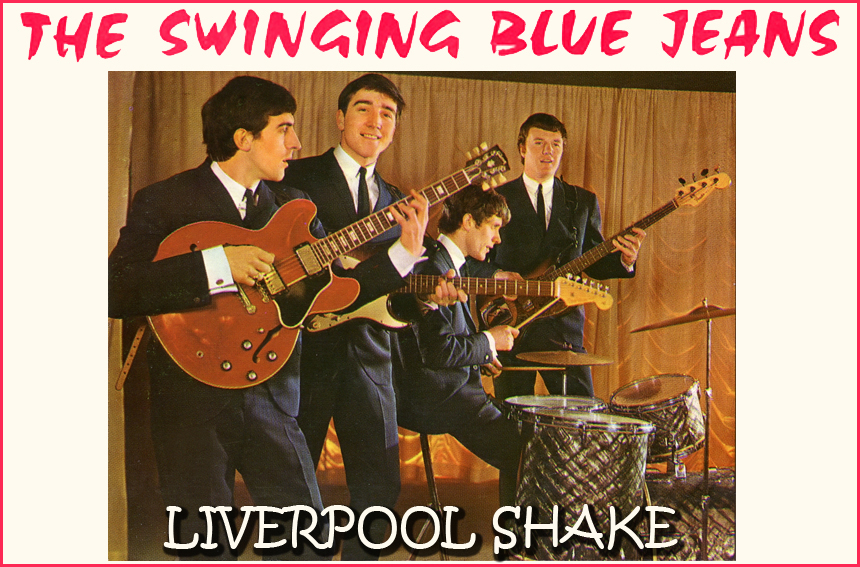
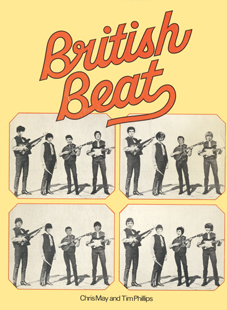
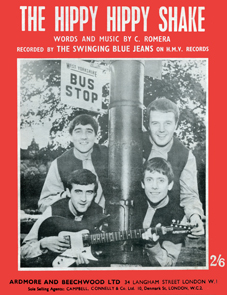
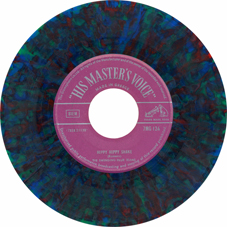
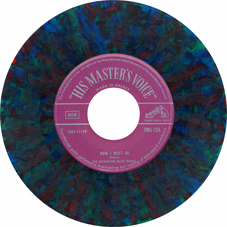
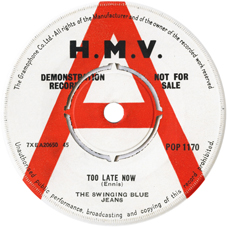
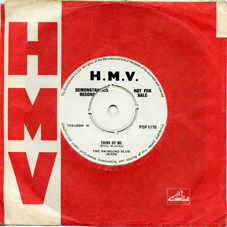
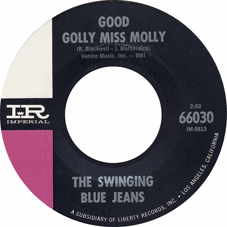
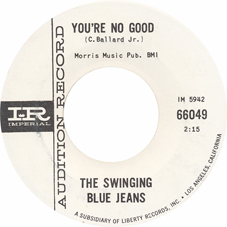
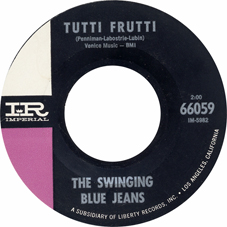
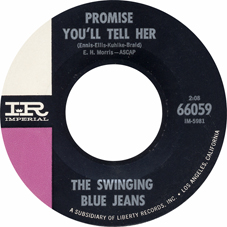
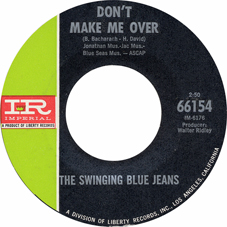
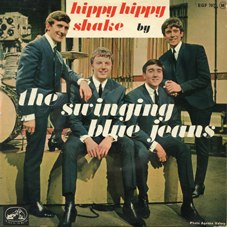
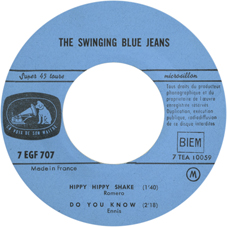
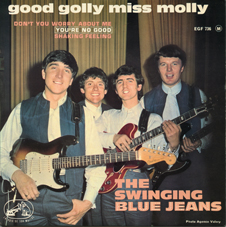
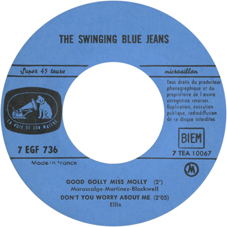
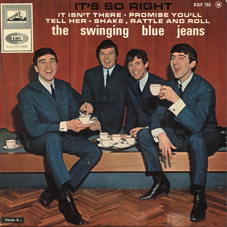
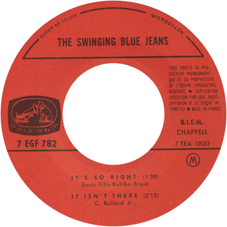
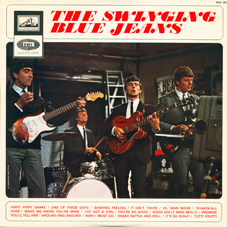
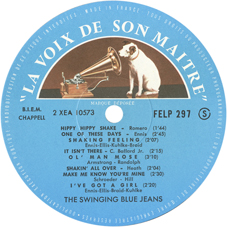
.jpg)
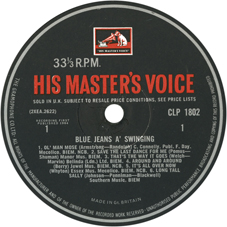
 5C 052-24732 PS.jpg)
 5C 052-24732.jpg)
.jpg)
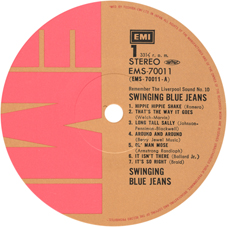
.jpg)
